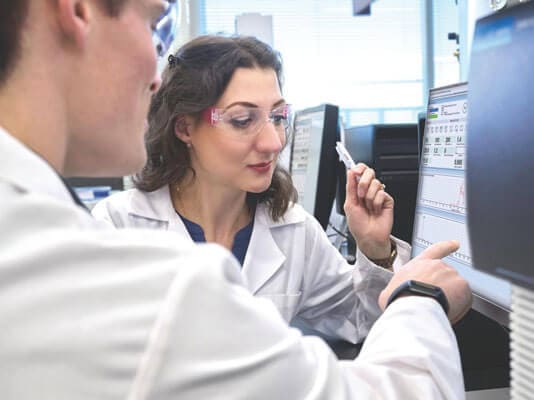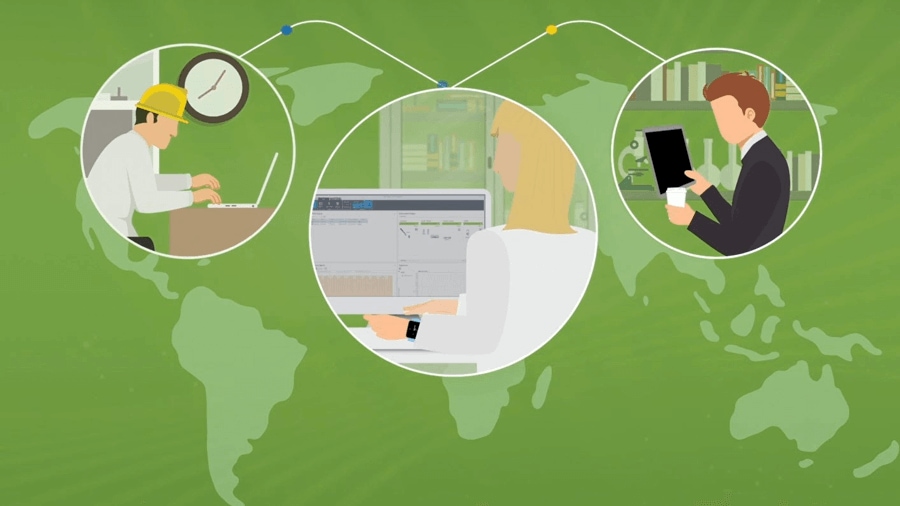Break down data silos with networked systems
A networked system is simply a way of connecting individual workstations so that laboratory systems and staff can work together. Sharing data and methods. Collaborating to streamline processes. Increasing efficiency. Accelerating the lab's workflow. In person or remotely.
The benefits are proven. So... why are some laboratories still hesitant to make the move to a networked system? Perhaps they have lost sight of the costs and risks of inertia.
Inaction carries a high price
Labs that have moved to a networked system have a leg up in terms of overall productivity, scalability, proficiency at identifying and resolving issues, and getting more testing done quickly and accurately. Bottom line: they can outperform labs that lag behind with isolated workstations.
When each system must be secured separately, the risk of a data loss increases during an outage. Tedious manual updates also add to the cost and complexity of securing the lab environment and introduce inconsistencies and errors that can lead to security and compliances breaches.
Isolated systems keep staff isolated. When it's difficult to share data, methods, results, and insights, people simply don't—and the lack of collaboration impacts the lab's performance and reputation.
A lab environment that supports interaction, teamwork, and resource sharing is far more appealing to lab staff, making it easier to find, recruit, hire, and retain top talent.
If you have 20 independent workstations, you constantly have to manage, monitor, update, and secure 20 separate systems. With a networked system, you get rid of inefficient maintenance processes and gain economies of scale that drive total support costs down.
A better option is right in front of you
A networked system gets your lab to a better place—quickly, cost-efficiently, and without disruption. Among the many advantages:
There is one system for managing users, instruments, and data, so it's easier to access information. The lab saves time managing and updating software and training staff.
User roles, permissions and privileges are centrally managed, strengthening data security and integrity while reducing unauthorized changes that could complicate compliance.
IT no longer has to manage each workstation individually, saving time and tedium. IT can now monitor the utilization and capacity of instruments across the entire lab, and automated data backup processes ensure critical data is always backed up, either on-premises or in the cloud.
Automated data capture and transfer eliminates the need for manual transcription, reducing the risk of human errors and increasing productivity.
Lab staff can control instruments and review status across the lab from any PC, which eliminates the need to purchase and set up dedicated workstations for each instrument.
The Agilent advantage starts with simplicity
The Agilent OpenLab CDS Client-Server system takes your lab's peak performance to new heights by centralizing instrument management and system administration. And Agilent has made it easy to make the transition. OpenLab CDS Client-Server offers:

Flexible lab operations
Flexible lab operations
- Enables hybrid work
- Frees staff from being tied to the lab
- Remote data processing, review, and approval
- Lab-at-a-Glance for quick user and instrument status views

Simpler management
Simpler management
- Streamlines system-wide operations across the entire lab from a single location
- Centralized, dashboard-based monitoring and management

Streamlined deployment
Streamlined deployment
- Fast, easy installation, guided by Agilent experts
- Site preparation checklists
- Optional Connected Instrument Device (CID), an all-in-one IT control hub for simplified configuration

Accessible training and support
Accessible training and support
- Online help and documentation
- Webinars and other training materials
- Customizable services from Agilent support and professional services teams
Enhance performance with add-ons
Elevate your lab's capabilities with these powerful add-ons, available exclusively for OpenLab CDS Client-Server.
Connected Instrument Device (CID)
This IoT solution simplifies client-server setup, significantly reduces resource requirements for deployment and management, and minimizes instrument downtime. Learn more
Status Board
A laboratory dashboard that continuously monitors your data system environment, spotting issues proactively to prevent downtime and maintain smooth operations. Learn more
Advanced Sample Linking
Streamlines sample handling and data linking throughout preparation and analysis, enhancing efficiency at your lab bench. Learn more
Data Accessibility Tool
Enables interactive exploration and visualization of OpenLab CDS data, unlocking deeper insights from results, samples, and instrument information.
Sample Scheduler
Simplifies sample submission and speeds up results. Optionally, integrate with your LIMS to automate common error-prone and time-consuming mistakes. Learn more
Our customers have achieved impressive results
Around the world, Agilent customers are reporting a broad spectrum of benefits to lab managers, research analysts, and IT staff from making the move to the client-server model.
Benefits of OpenLab CDS Client-Server: Summary
-
Lower cost of ownership:
- Less expensive and faster to add instruments
- Lower total support costs through centralized management
- Simpler integration with other systems from LIMS to data visualization tools ensures a seamless flow of information across your lab
- Accelerated performance and enhanced efficiency through automation and streamlined processes
- Standardized report templates ensure consistency across all lab documentation
- No need to configure, manage, and support lab workstations when IT manages centrally
- Innovative features and enhanced technical controls for robust regulatory compliance support
- No need for tedious, time-consuming individual workstation updates and security management tasks
- Maximum uptime through centralized monitoring and control means less troubleshooting and remediation work
- Future-ready: scalable to cloud for data storage and deployment (select configurations only)
- Industry-standard architecture accommodates laboratory growth
- Access to all instruments and data remotely without having to be in the lab
- Easy to learn, easy to use, plenty of training materials and support available
- Fewer mistakes and more transparency through centralized method sharing and comprehensive activity logs
- Easier collaboration with colleagues, regardless of location
Ready to get started?
Agilent has considerable experience helping clients migrate to a networked chromatography system. Contact us to discuss your specific requirements and goals.
Contact us










